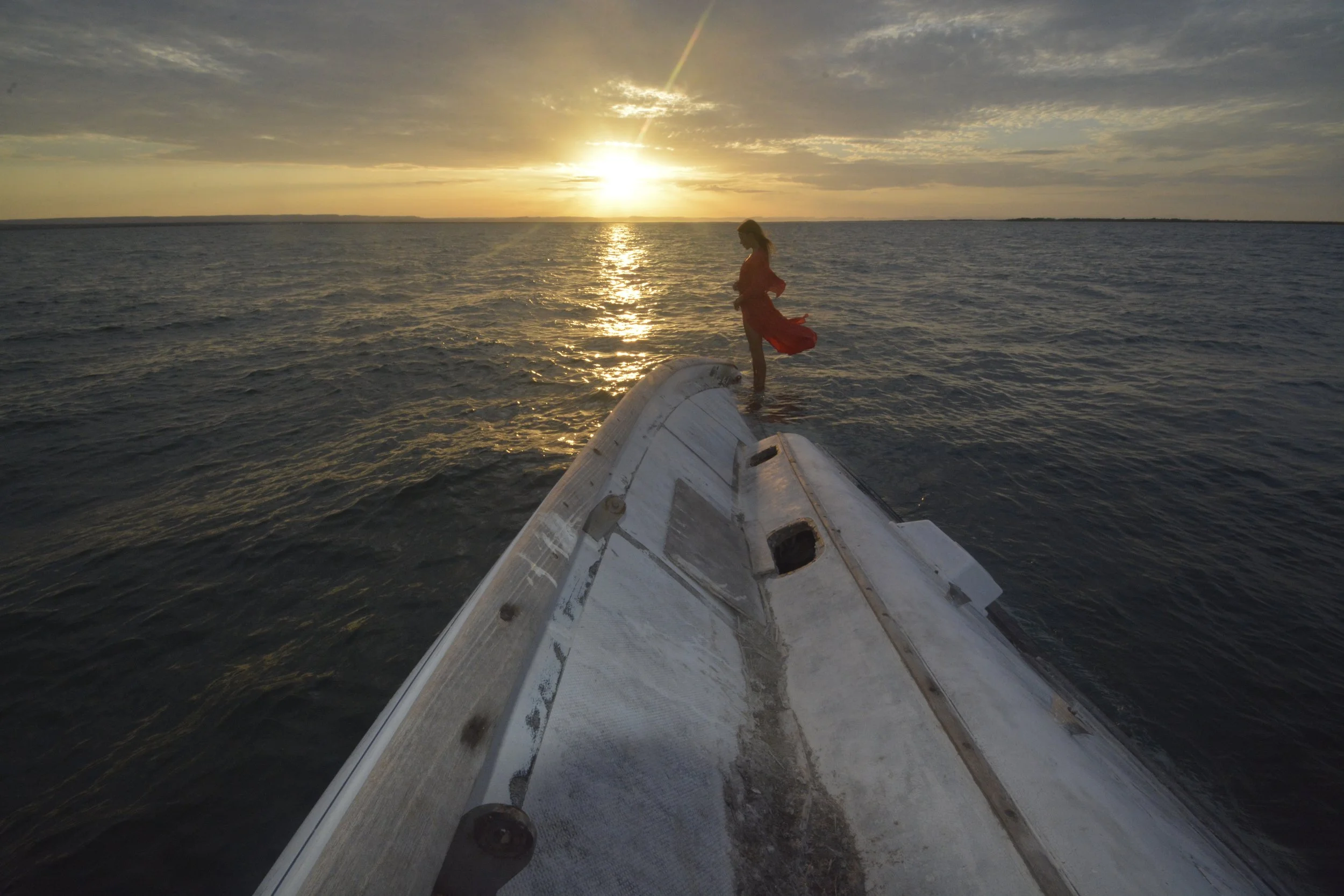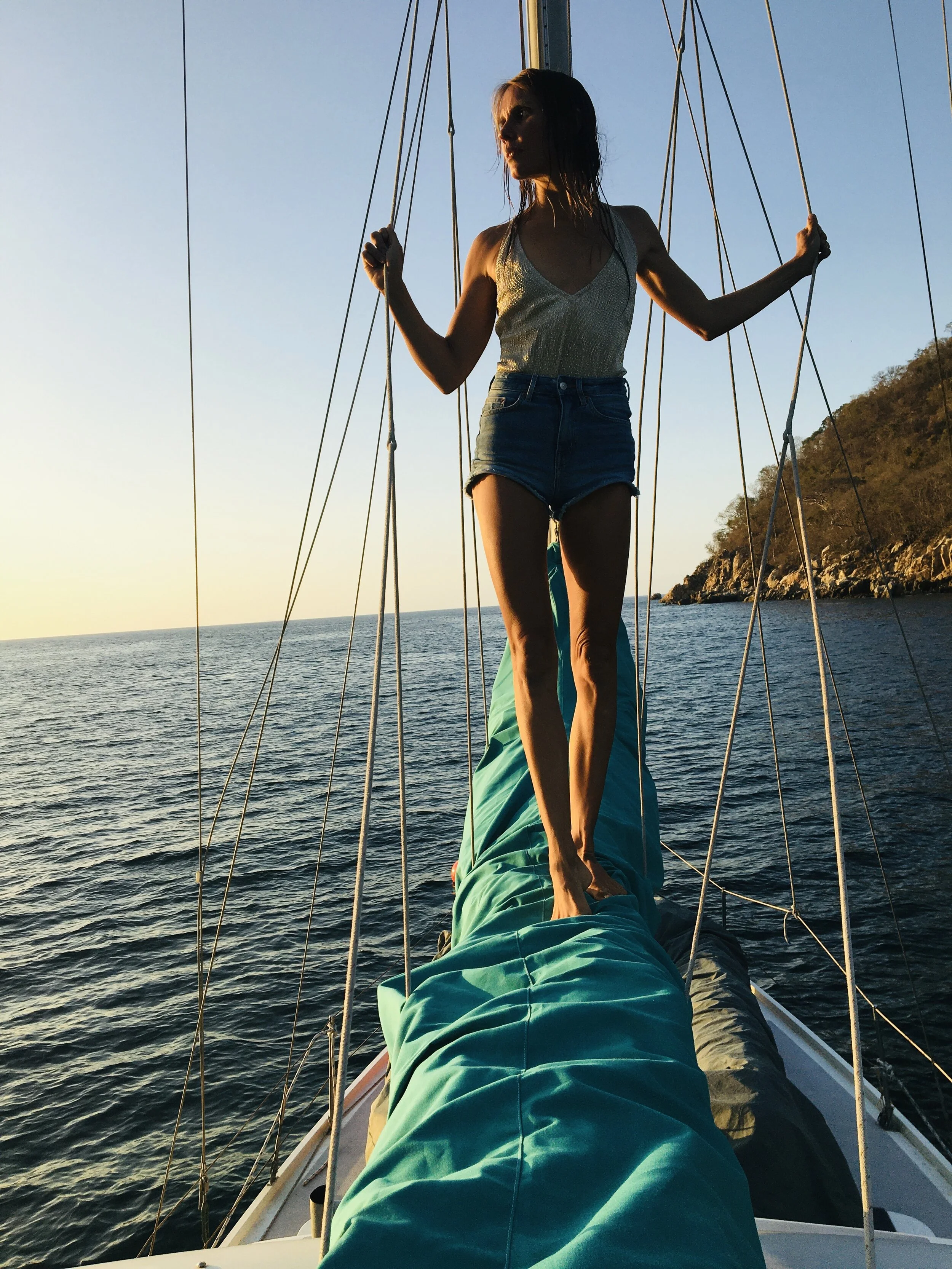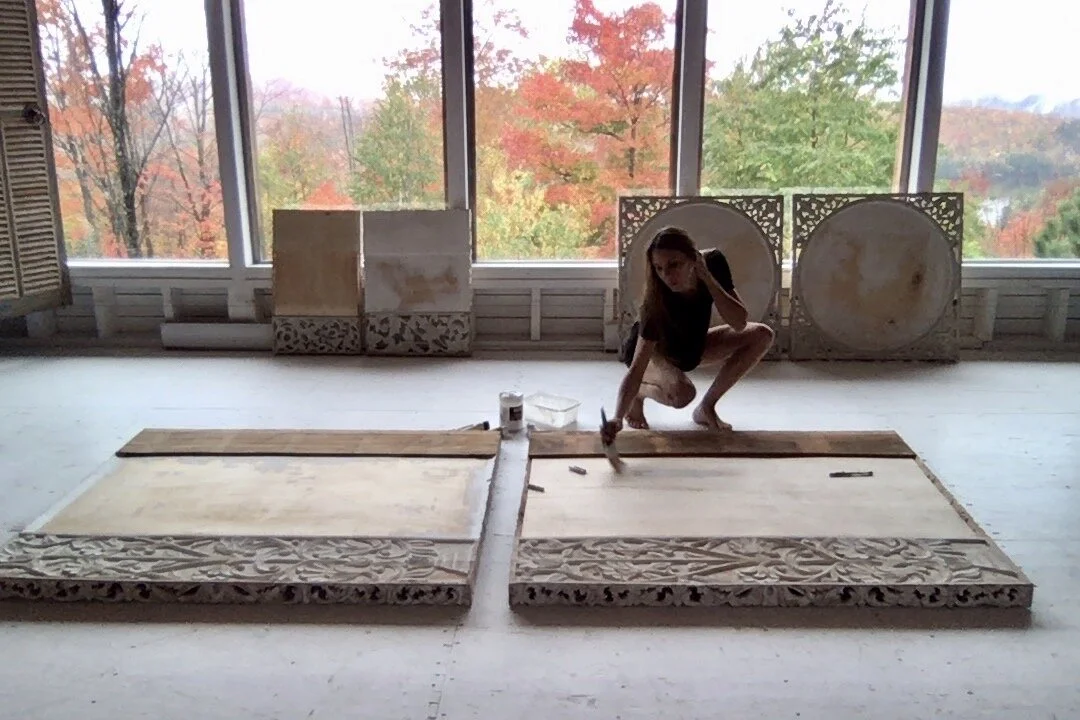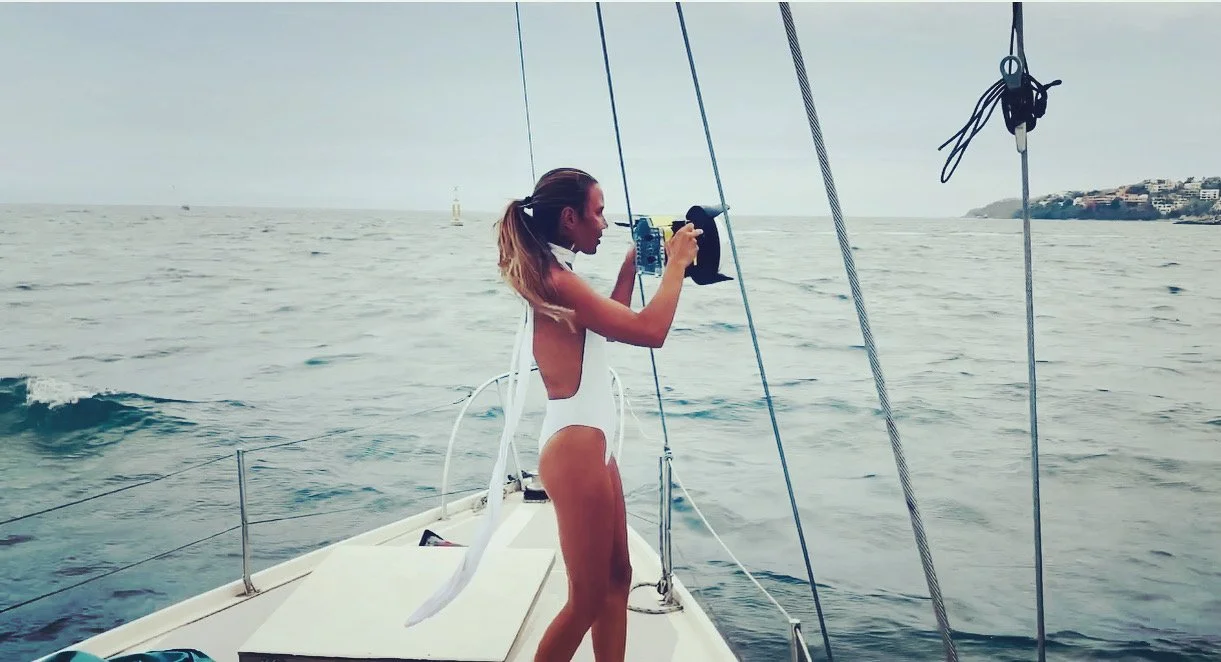
AMELIE DESJARDINS
Where were you born?
I was born in Quebec and grew up in a small village about an hour from Montreal. My parent’s house stands by a great river, every year hundreds of migratory birds stay there for a couple of months. As a child I used to look at them for hours, they’ve always fascinated me and inspired me, as you can tell when you see my paintings.
2) Did you go to school for visual arts or something entirely different?
I followed an Art curriculum in College and then went to UQAM in Montreal. But after a year of university, I felt too eager to travel and to create, so I dropped out and became an autodidact. More time, more freedom.
3) Who or what inspired you growing up?
When there were no more birds on my river, I used to skip classes and visit libraries. I would look at any book with pictures about travel, or about the sea. I’ve always had a sweet tooth for National Geographic magazines, but a book that deeply touched me was Ocean-sea by Alessandro Baricco.
4) What was your first big adventure? Was there a defining moment in which you felt the lure to engage and be curious about the world?
The defining moment was clearly that first year of university. I could feel in my heart and bones that the world was too big to just sit there! I first went to Mexico for a few months but my initiatory journey was the year I spent in India. This was so different from everything I knew, it made me realize that there was so much to discover, to see, to taste, to touch. I haven’t stopped since.
5) What are or were your mediums of choice that you used to express, and why did you choose these?
I like to mix photography, painting, drawing, texture et recycled wood. It looks like a lot of different techniques but when you travel all your senses are solicited and I wanted these feelings to be reflected in my art.
6) Describe your process which incorporates elements of reusable materials, natural materials, into your work? What inspired this?
What inspired me in the first place was that the materials I use have a history, a memory that I wanted to share. I feel so inspired to just imagine all the things a piece of a boat could have been through! Those memories are imprinted in the matter and fossilized into it. Every piece of art tells a story that goes beyond my work, you can let that story inspire you, smell the sea breeze, hear the waves, imagine a journey. I build my canvas by juxtaposing poetic pictures that I take all around the world. Our lifestyle inspired my process (or maybe it’s the other way around?)
7) When did you choose to start using wood, and mixed materials in your work? Is there an environmental or eco-sensibility or thought process in your work?
One day, as I was sitting on the back of a motorcycle, holding onto my sweetie, I noticed a boat being unbuilt. There was poetry in this wood, something about the passing of time that inspired me. Since then, to find those pieces, we go on treasure hunts with my family, roaming beaches and boat cemeteries, looking for shipwrecks and grounded treasures. If there is an environmental dimension in my work, it is a poetic one, thinking of a tree, that became wood, that became a boat, worn by the sea, the wind, the salt, and men, growing a history that is now shared in my art. Old things don’t need to be thrown away, there is beauty in them.
8) Exploring seems to be an integral part of your life and lifestyle. Why do you explore? What are some of the reasons you feel enticed to go and see and be in nature or unfamiliar territory?
I exist through motion! I am nurtured by new horizons, new smells, tastes, and textures. Travel is my vision of freedom, like birds, I go over the Earth and across cultures without feeling entitled to one. Khalil Gibran said « The bird has an honor that man does not have. Man lives in the traps of his abdicated laws and traditions, but the birds live according to the natural law of God who causes the earth to turn around the sun », that’s how I want to feel.
9) What do you feel are the biggest benefits to having your kids travel?
If I’d have to pick 3 main benefits (because there are so many), I’d say an open mind, a deep curiosity, and adaptability. Over the years we’ve lived in many countries and in many ways. Just imagine growing up on a sailboat in Mexico, in a motorhome in the US parks, cruising down the Irrawaddy river in Myanmar, living in a jungle house in Bali (chasing monkey thieves),… Opportunities to learn and grow are endless, as well as discovering that there is more to the world than we think.
10) What are some of your biggest adventures as a family?
We’ve had so many adventures, I couldn’t choose (laugh). Since our children were babies we’ve been traveling 6 to 8 months a year. Those children are nomads at heart and adapt to any country, situation, food, or housing.
We’ve traveled by train and by motorbike in India, we zig-zagged through the US and Mexico in a motorhome, took too many planes to recall them all, took every possible means of crazy transportation in Asia (the Thai buses are an experience!), and now we sail on the sea of Cortez.
11) Being in nature or by water seems to be one of your biggest themes?
Who wouldn’t be in awe when facing the ocean? You feel at the same time infinite and yet very alive, grounded. For me it is a symbol of freedom and of possibilities: wherever you look, there might be something magical happening. It is also soothing to just let your eyes rest and listen to the music of the waves. I think that these ambivalences, calm and power, infinite and present, poetry and wilderness are what inspires me so much.
12) Do you find being creative is healing? Do you often find yourself in a creative zone, when in the studio?
I would compare creation to active meditation. I empty my mind of all thoughts and let the energy that results from it vibrates through me, all the way to my hand and brush. Those moments in my studio are precious to me. I gather all the treasures we found and give them a new life.
13) What has made the greatest impact on your lives this year during this pandemic?
When we started to hear about the pandemic, we were in an eco-house in a Mexican jungle. There we took the time to consider our dreams and our vision of life in this new optic. I would never give up on my aspirations. And in the end, we decided that the best for us was to be on the sea, which is the purest and most free place for us. So we bought a sailboat on the sea of Cortez and here we are!
14) Have you been just as creative as before or more introspective this year?
Definitely more introspective. To express this experience, I made portraits of me underwater using an underwater camera, to symbolize this self-reflection process. Water is where we come from, and in nature, we can always recharge ourselves, no matter how stressful the world can be.
15) If you could mentor a young artist what words of advice would give them on creativity?
Make your brush swing! Don’t hesitate in front of a white page or canvas. Go for it! Overthinking is not helping.
Any words of advice on exploration?
I’d say, better try everything that comes to hand, play with materials and textures, be bold, and not trying to « make » something. Thinking about what you will create is not creating, go more into your body and less into your mind.
16) What are some of the future projects you will be working on in the year to come?
After experiencing underwater photography I decided to buy some professional equipment and explore more of it. I especially like the concept of half-immersed pictures, to create a bond between the two worlds: sea and air (land?). We plan on crossing the sea of Cortez so that should give me plenty of opportunities! You’ll get to see some of my favorite shots later this year during the exhibition I’m creating for Thompson Landry in Toronto.
17 ) Where to next? With your art and your adventures?
I read one day that traveling outgrows its motives. You think you are making a trip, but soon it is making you. I think it was Nicolas Bouvier. I am a free person, I follow my inspiration, I let encounters guide me, and in the end, I never know where I’ll end up. An open mind and heart, a keen eye for beautiful pieces with a history, and a studio. I am all set for any art adventure!
18) What do you feel is your general manta or motto to your life?
Stay in the present, let the world amaze you, and be open to the extraordinary. But Khalil Gibran said it way better than me: « Yesterday is but today’s memory, and tomorrow is today’s dream. » There is so much to live and experiment with, I don’t want to waste my energy on regrets or plans that might never happen.
19) What are some of your personal challenges that arise from your work. How do you overcome or work through it?
The fact that I use recycled wood from all around the world raises plenty of challenges, like getting it to Quebec for a start! But when I see a finished piece, with all its meaning and poetry, I always feel it was worth the effort to arrive there.
AMELIE DESJARDINS
INSTAGRAM- @amelie_desjardins_artiste
From tree, to shipwreck, to artwork, the creative process of Amélie Desjardins encompasses a complete life cycle.
Desjardins is a nomad and in order to find the materials she has used over the course of her 15 year art career, she has travelled the world by train, motorbike and sailboat all the while seeking out lost treasures. From these vestiges of bridges and boats, Desjardins juxtaposes poetic images onto the reclaimed structures. A sailing story from one of the Pacific Islands where Amélie has sailed and traveled for many years, well states the premise of her artistic intention:
"Every man is torn between two needs. The need of the Pirogue, that is to say of the journey of adventure, and the need of the Tree, that is to say of the rooting, of belonging to a community. Men are constantly wandering between these two needs, sometimes yielding to one, sometimes to the other until the day when they understand that it is with the Tree that the Pirogue is made.”
It is within this framework, that the artist highlights the fusion of sedentary life (represented by the tree) and adventure (represented by boats and bridges).
In that she uses organic matter culled from her travels, it is fitting that Desjardins consciously emphasizes the accumulation of scars, fossils, and memories through both the passage of time and the omnipresence of nature. Her approach is based both on the recovery of materials and a lyrical vision of the passage of time. Desjardins can be found in both private and museum collections and her work has been a part of many Solo Exhibitions nationally and internationally.

















